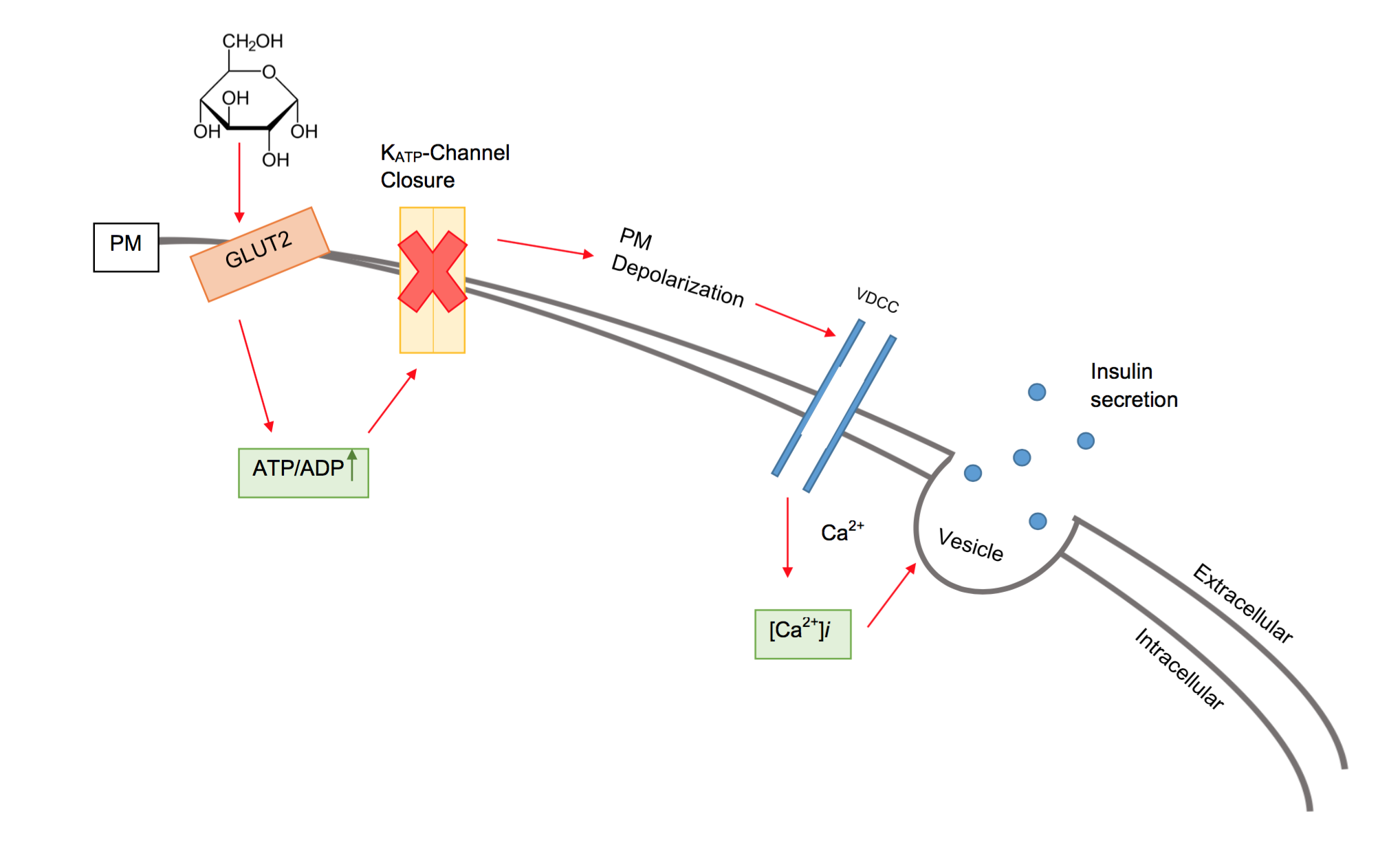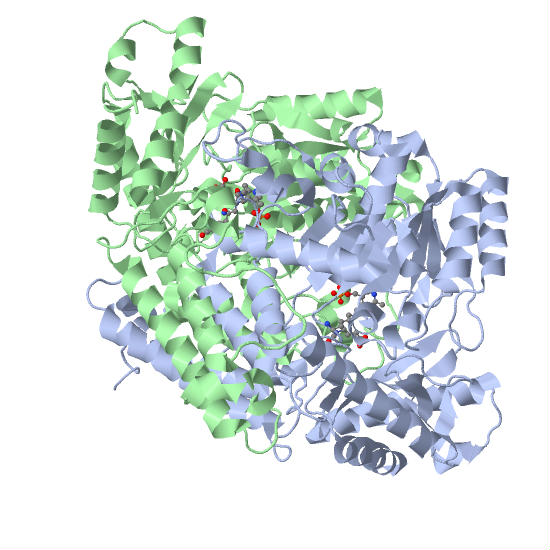|
Ketosis-prone Diabetes
Ketosis-prone diabetes (KPD) is an intermediate form of diabetes that has some characteristics of type 1 and some of type 2 diabetes. Type 1 diabetes involves autoimmune destruction of pancreatic beta cells which create insulin. This occurs earlier in a person's life, leading to patients being insulin dependent, and the lack of natural insulin makes patients prone to a condition called diabetic ketoacidosis (DKA). Type 2 diabetes is different in that it is usually caused by insulin resistance in the body in older patients leading to beta cell burnout over time, and is not prone to DKA. KPD is a condition that involves DKA like type 1, but occurs later in life and can regain beta cell function like type 2 diabetes. However, it is distinct from latent autoimmune diabetes of adults (LADA), a form of type 1 sometimes referred to as type 1.5 that does not occur with DKA. There are also distinctions to be made between KPD and LADA as patients who exhibit KPD symptoms can regain beta ... [...More Info...] [...Related Items...] OR: [Wikipedia] [Google] [Baidu] |
Diabetes Mellitus Type 1
Type 1 diabetes (T1D), formerly known as juvenile diabetes, is an autoimmune disease that originates when cells that make insulin (beta cells) are destroyed by the immune system. Insulin is a hormone required for the cells to use blood sugar for energy and it helps regulate glucose levels in the bloodstream. Before treatment this results in high blood sugar levels in the body. The common symptoms of this elevated blood sugar are frequent urination, increased thirst, increased hunger, weight loss, and other serious complications. Additional symptoms may include blurry vision, tiredness, and slow wound healing. Symptoms typically develop over a short period of time, often a matter of weeks. The cause of type 1 diabetes is unknown, but it is believed to involve a combination of genetic and environmental factors. The underlying mechanism involves an autoimmune destruction of the insulin-producing beta cells in the pancreas. Diabetes is diagnosed by testing the level of sugar or ... [...More Info...] [...Related Items...] OR: [Wikipedia] [Google] [Baidu] |
Diabetes Mellitus Type 2
Type 2 diabetes, formerly known as adult-onset diabetes, is a form of diabetes mellitus that is characterized by high blood sugar, insulin resistance, and relative lack of insulin. Common symptoms include increased thirst, frequent urination, and unexplained weight loss. Symptoms may also include increased hunger, feeling tired, and sores that do not heal. Often symptoms come on slowly. Long-term complications from high blood sugar include heart disease, strokes, diabetic retinopathy which can result in blindness, kidney failure, and poor blood flow in the limbs which may lead to amputations. The sudden onset of hyperosmolar hyperglycemic state may occur; however, ketoacidosis is uncommon. Type 2 diabetes primarily occurs as a result of obesity and lack of exercise. Some people are genetically more at risk than others. Type 2 diabetes makes up about 90% of cases of diabetes, with the other 10% due primarily to type 1 diabetes and gestational diabetes. In type 1 diabet ... [...More Info...] [...Related Items...] OR: [Wikipedia] [Google] [Baidu] |
Beta Cell
Beta cells (β-cells) are a type of cell found in pancreatic islets that synthesize and secrete insulin and amylin. Beta cells make up 50–70% of the cells in human islets. In patients with Type 1 diabetes, beta-cell mass and function are diminished, leading to insufficient insulin secretion and hyperglycemia. Function The primary function of a beta cell is to produce and release insulin and amylin. Both are hormones which reduce blood glucose levels by different mechanisms. Beta cells can respond quickly to spikes in blood glucose concentrations by secreting some of their stored insulin and amylin while simultaneously producing more. Primary cilia on beta cells regulate their function and energy metabolism. Cilia deletion can lead to islet dysfunction and type 2 diabetes. Insulin synthesis Beta cells are the only site of insulin synthesis in mammals. As glucose stimulates insulin secretion, it simultaneously increases proinsulin biosynthesis, mainly through translational cont ... [...More Info...] [...Related Items...] OR: [Wikipedia] [Google] [Baidu] |
Diabetic Ketoacidosis
Diabetic ketoacidosis (DKA) is a potentially life-threatening complication of diabetes mellitus. Signs and symptoms may include vomiting, abdominal pain, deep gasping breathing, increased urination, weakness, confusion and occasionally loss of consciousness. A person's breath may develop a specific "fruity" smell. Onset of symptoms is usually rapid. People without a previous diagnosis of diabetes may develop DKA as the first obvious symptom. DKA happens most often in those with type 1 diabetes but can also occur in those with other types of diabetes under certain circumstances. Triggers may include infection, not taking insulin correctly, stroke and certain medications such as steroids. DKA results from a shortage of insulin; in response, the body switches to burning fatty acids, which produces acidic ketone bodies. DKA is typically diagnosed when testing finds high blood sugar, low blood pH and ketoacids in either the blood or urine. The primary treatment of DKA is with ... [...More Info...] [...Related Items...] OR: [Wikipedia] [Google] [Baidu] |
Latent Autoimmune Diabetes Of Adults
Slowly evolving immune-mediated diabetes, or latent autoimmune diabetes in adults (LADA), is a form of diabetes that exhibits clinical features similar to both type 1 diabetes (T1D) and type 2 diabetes (T2D), and is sometimes referred to as type 1.5 diabetes. It is an autoimmune form of diabetes, similar to T1D, but patients with LADA often show insulin resistance, similar to T2D, and share some risk factors for the disease with T2D. Studies have shown that LADA patients have certain types of antibodies against the insulin-producing cells, and that these cells stop producing insulin more slowly than in T1D patients. LADA appears to share genetic risk factors with both T1D and T2D but is genetically distinct from both. Within the LADA patient group, a genetic and phenotypic heterogeneity has been observed with varying degrees of insulin resistance and autoimmunity. With the knowledge we have today, LADA can thus be described as a hybrid form of T1D and T2D, showing phenotypic and ... [...More Info...] [...Related Items...] OR: [Wikipedia] [Google] [Baidu] |
Ketoacidosis
Ketoacidosis is a metabolic state caused by uncontrolled production of ketone bodies that cause a metabolic acidosis. While ketosis refers to any elevation of blood ketones, ketoacidosis is a specific pathologic condition that results in changes in blood pH and requires medical attention. The most common cause of ketoacidosis is diabetic ketoacidosis but can also be caused by alcohol, medications, toxins, and rarely, starvation. Signs and symptoms The symptoms of ketoacidosis are variable depending on the underlying cause. The most common symptoms include nausea, vomiting, abdominal pain, and weakness. Breath may also develop the smell of acetone as it is a volatile ketone that can be exhaled. Rapid deep breathing, or Kussmaul breathing, may be present to compensate for the metabolic acidosis. Altered mental status is more common in diabetic than alcoholic ketoacidosis. Causes Ketoacidosis is caused by the uncontrolled production of ketone bodies. Usually the production of keton ... [...More Info...] [...Related Items...] OR: [Wikipedia] [Google] [Baidu] |
C-peptide
The connecting peptide, or C-peptide, is a short 31-amino-acid polypeptide that connects insulin, insulin's A-chain to its B-chain in the proinsulin molecule. In the context of diabetes or hypoglycemia, a measurement of C-peptide blood serum levels can be used to Differential diagnosis, distinguish between different conditions with similar clinical features. In the insulin synthesis pathway, first preproinsulin is translocated into the endoplasmic reticulum of beta cells of the pancreas with an A-chain, a C-peptide, a B-chain, and a signal peptide, signal sequence. The signal sequence is cleaved from the N-terminus of the peptide by a signal peptidase, leaving proinsulin. After proinsulin is packaged into vesicles in the Golgi apparatus (beta-granules), the C-peptide is removed, leaving the A-chain and B-chain bound together by disulfide bonds, that constitute the insulin molecule. History Proinsulin C-peptide was first described in 1967 in connection with the discovery of the ... [...More Info...] [...Related Items...] OR: [Wikipedia] [Google] [Baidu] |
Aging-associated Diseases
An aging-associated disease (commonly termed age-related disease, ARD) is a disease that is most often seen with increasing frequency with increasing senescence. They are essentially complications of senescence, distinguished from the aging process itself because all adult animals age ( with rare exceptions) but not all adult animals experience all age-associated diseases. The term does not refer to age-specific diseases, such as the childhood diseases chicken pox and measles, only diseases of the elderly. They are also not accelerated aging diseases, all of which are genetic disorders. Examples of aging-associated diseases are atherosclerosis and cardiovascular disease, cancer, arthritis, cataracts, osteoporosis, type 2 diabetes, hypertension and Alzheimer's disease. The incidence of all of these diseases increases exponentially with age. Of the roughly 150,000 people who die each day across the globe, about two thirds—100,000 per day—die of age-related cause ... [...More Info...] [...Related Items...] OR: [Wikipedia] [Google] [Baidu] |
Diabetes
Diabetes, also known as diabetes mellitus, is a group of metabolic disorders characterized by a high blood sugar level ( hyperglycemia) over a prolonged period of time. Symptoms often include frequent urination, increased thirst and increased appetite. If left untreated, diabetes can cause many health complications. Acute complications can include diabetic ketoacidosis, hyperosmolar hyperglycemic state, or death. Serious long-term complications include cardiovascular disease, stroke, chronic kidney disease, foot ulcers, damage to the nerves, damage to the eyes, and cognitive impairment. Diabetes is due to either the pancreas not producing enough insulin, or the cells of the body not responding properly to the insulin produced. Insulin is a hormone which is responsible for helping glucose from food get into cells to be used for energy. There are three main types of diabetes mellitus: * Type 1 diabetes results from failure of the pancreas to produce enough insulin due to lo ... [...More Info...] [...Related Items...] OR: [Wikipedia] [Google] [Baidu] |



